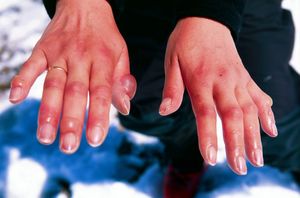By the time you are suffering from frostbite, it may be too late. The problem with frostbite is that it begins to affect you once your extremities have already gone numb. As a result, the numbness serves to deaden the signs that should be warning you that you are about to face some serious pain in the near future. Not all frostbite is created equally; there are actually three separate degrees of frostbite: frostnip, superficial frostbite, and deep frostbite.
Frostnip arrives with that sense of numbness, followed by the telltale whitening of your skin tissue. With frostnip this numbing and whitening can occur very quickly and typically will affect the hands, ears and nose first. If for some reason you happen to be out in the cold without shoes or if your feet are allowed to get wet, frostnip can attack your toes quickly as well. The best way to deal with the appearance of the symptoms of frostnip is to simply get out of the cold. If this solution is not practical, then do what you see millions of people doing every winter: blow on your hands and rub your exposed facial areas. You might also try hiding your hands in your armpits since that is one the last areas on the human body to feel the effects of the cold. You could also try putting your hands down your pants, but that might be a little uncomfortable, though potentially far less uncomfortable than frostnip.
Superficial frostbite is going to mean a trip to the emergency room because, despite its name, it can result in serious injury. You can usually spot the different between frostnip and superficial frostbite by the degree of whitening of the skin around the affected area. Whereas frostnip results in merely a whitening, by the time the situation has reached the level of superficial frostbite, the skin will be uncommonly white as well as waxy in appearance and tough to the touch. At the point that frostnip turns into superficial frostbite, no matter how practical the situation, it is incumbent upon you to get out of the cold. In fact, once you get out of the cold, you should sink into a bathtub filled with hot water. The idea temperature for dealing with superficial frostbite is a little over 100 degrees. Continue to add heated water, but make sure it the temperature of the water does not climb over 105 degrees. If the only place you can get to is back to a campsite, do not try to get warm in front of a fire; avoid all dry heat when dealing with superficial frostbite.
Deep frostbite is the ultimate frostbite. Your skin tissue in the stage of deep frostbite will no longer be white, it will either have turned blue or become splotchy. Unlike with superficial frostbite, your skin be hard to the touch, showing no resilience if you press it. And, really, you should not press against skin suffering from deep frostbite because it will be incredibly painful. Essentially what happen during deep frostbite is that the affected become frozen. Do not try to thaw the parts of your body that is suffering from deep frostbite. The only thing you can really do is wrap the area in a warm covering such as blanket and get yourself to a hospital.
Sources:
http://www.climbing-high.com/frostbite.html
